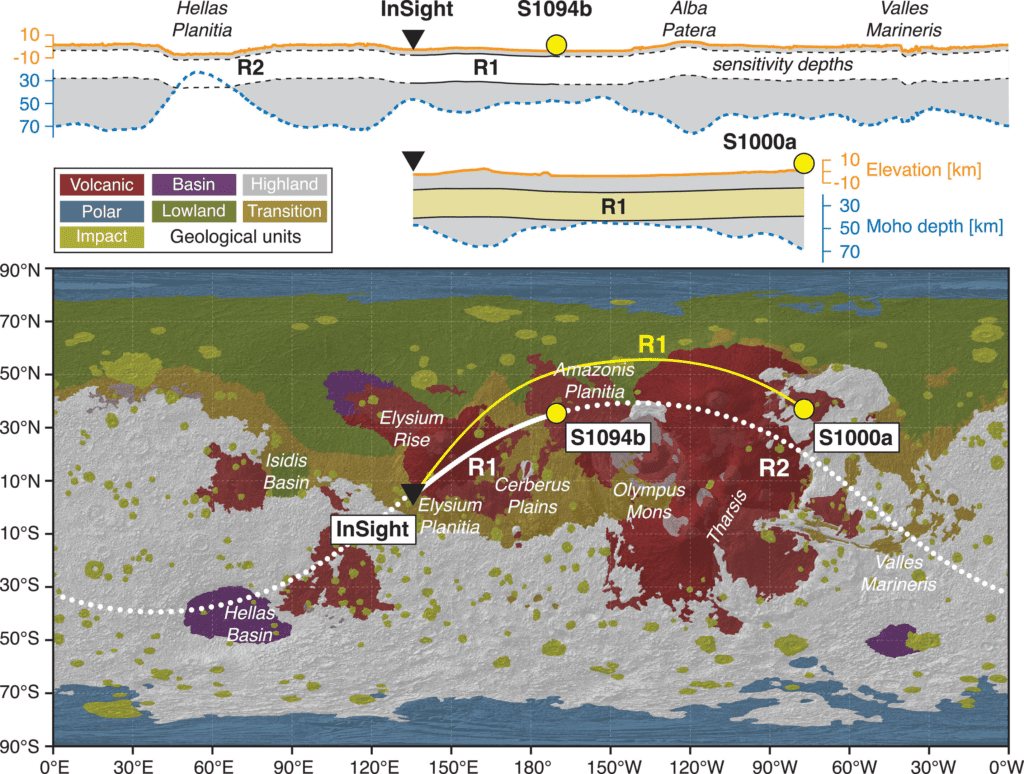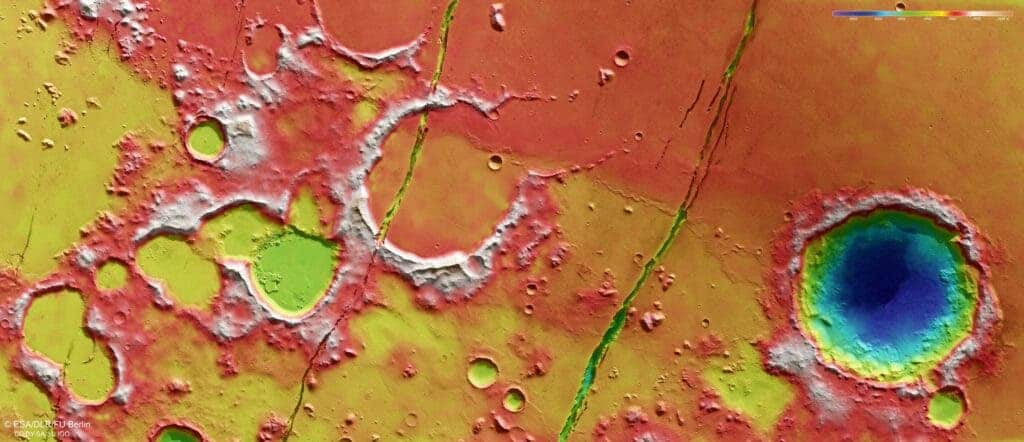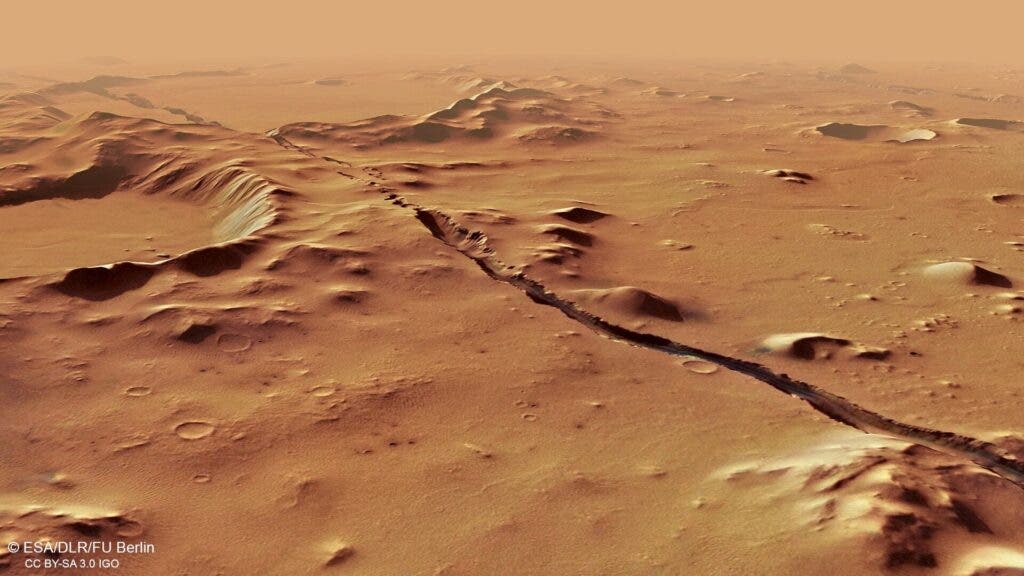Just one day before Christmas, on 24 December 2021, NASA’s InSight lander recorded a large seismic event — one of the largest ever recorded on Mars. Using that temblor (which turned out to be a meteorite impact) and several smaller marsquakes, several teams of researchers have pieced together more information about the Martian interior than ever before.

Listening closely to the rumble
Much of what we know about Earth’s internal structure comes from earthquakes. We’ve literally only scratched the surface of the Earth directly: the deepest hole we’ve ever dug is around 12,000 meters (40,000 ft), and that’s nothing compared to the thickness of the crust, which is around 30 km under continents, let alone the mantle, which is a whopping 2,900 kilometers (1,802 miles) thick.
But even without seeing it with our own eyes, we can use earthquakes to “see” the planet’s internal structure. Whenever an earthquake (or marsquake) happens, it sends out seismic waves. These waves are essentially acoustic waves that propagate through the subsurface — but they propagate differently through different subsurfaces. So if you have a network of devices to record the waves at different spots in the world, you can piece together various things about the subsurface. The good news is that we have this on Earth, and that’s how we know about the core, the mantle, and the crust; but on Mars, we only have one seismometer: the InSight lander.
To make matters even more tricky, Mars isn’t nearly as geologically active as Earth. In fact, Mars is almost (but not totally) inactive geologically, which means less seismic information to work with. It has no tectonic plates, which are the main driver of earthquakes, but it may have an active fault zone. Plus, every now and then, it gets struck by meteorites, which also produce seismic waves.
This is exactly what happened in late 2021. Researchers noted seismic waves with unusual characteristics, whose source appeared to be very close to the surface. So they thought what if the source was actually at the surface? They checked images taken by the Mars Reconnaissance Orbiter in late December 2021 and lo and behold: the images showed a large impact crater about 3,500 kilometers from InSight, exactly where the epicenter was expected.
“The location was a good match with our estimates for the source of the quake,” says Doyeon Kim, a geophysicist and senior research scientist at ETH Zurich’s Institute of Geophysics. Kim is the lead author of a study that has just been published in the journal Science.

Figuring out that the temblors were caused by meteorites is already a notable achievement. In one study, a team led by Liliya Posiolova, a senior scientist at Malin Space Science Systems, which operates two cameras on NASA’s Mars Reconnaissance Orbiter, describe how these meteor impacts were linked to the marsquakes. These collisions resulted in two large impact craters (over 130 meters in diameter) and sent seismic waves reverberating across the planet.
These marsquakes offer new insights into the structure of the planet’s crust and mantle, which in turn provide important information about the planet’s evolution.
“Before this, all our knowledge of the Martian crust was based on what was right below the InSight lander,” said UMD Associate Professor of Geology Vedran Lekic, a co-author of the paper. “But Mars is a big planet—we didn’t know if the crust was different in other locations across the planet. With these surface waves, we were finally able to obtain a better understanding of the crust along a big stretch of Mars.”
Information from marsquakes enabled a research team that included Hrvoje Tkalčić Australian National University in Canberra to determine the approximate diameter of the Martian core: about 3,620 kilometers (2,248 miles) in diameter. For comparison, the Earth’s core diameter is 3,485 kilometers (2,165 miles).
“Our research presents an innovative method using a single instrument to scan the interior of any planet in a way that’s never been done before,” Tkalčić said.

But because the temblors took place so close to the surface, there was an added bonus: surface waves.
Surface waves
When an earthquake happens, it sends various types of waves. The first ones are the primary waves, and then there are the secondary waves — but there’s another type of wave called surface waves.
Here on Earth, surface waves are the ones that cause the most damage to buildings and infrastructure. These surface waves travel slower and are attenuated in deeper earthquakes, but are very strong in shallow earthquakes.
“This is the first time seismic surface waves have been observed on a planet other than Earth. Not even the Apollo missions to the moon managed it,” said the study’s lead author, Doyeon Kim. Kim is currently a visiting assistant professor at the UMD Department of Geology and a senior assistant at the ETH Institute of Geophysics.

As the name implies, surface waves propagate closer to the surface, and they can offer a lot of information about a planet’s crust. Planetary crusts, including that of Mars and Earth, are solid, rigid, and resulted from the processes in the mantle. However, unlike the mantle or the core, the planetary crust is also exposed to the surface, and is therefore shaped by processes like sedimentation, erosion, volcanism, and impact cratering. Like scar marks, the crust bears the signs of the phenomena it was exposed to — but sometimes, these are not visible on the surface.
This is where the surface waves come in. The velocity of surface waves coming from the two meteorite impacts enabled the researchers to test the average properties of the crust between the meteorite impacts and the lander location, some 3 to 19 miles below the surface, offering indirect information about things like rock density or porosity.
The average Martian crust on this path does not seem to differ in these properties with depth, and seems to have a faster seismic velocity than the rocks previously observed directly below the lander.
This could perhaps be explained by volcanic activity in the area.
“The composition of the crust will determine some of the density, but so will factors like porosity; if you have a lot of holes in the crust, it can also decrease the density of the material,” explained UMD Associate Professor of Geology Nicholas Schmerr, another co-author of the paper. “A volcano, with all its intrusions and magma coming up through the crust beneath it, would have also altered the crust density and composition in that region. As we look further north on Mars, there’s probably some subsurface ice in the crust below the impact site, which is less porous and very different from what we see under the InSight lander.”
But even more compelling evidence for the existence of magma on Mars came from a different study.
Magma beneath the surface

In addition to the marsquakes caused by the meteorites, researchers have been “listening” to the acoustic waves of over 1,300 marsquakes. In particular, 20 or so quakes were very interesting. These quakes have epicenters originating in a structure called the Cerberus Fossae graben system. The seismic waves from these earthquakes indicate a pattern that could potentially be explained by a warm source, such as molten rock — magma.
Of course, this is only one possible explanation, so researchers looked for more evidence, and they found it, once again, at the surface. Specifically, they found darker deposits of dust around the Cerebus Fossae unit.
“The darker shade of the dust signifies geological evidence of more recent volcanic activity—perhaps within the past 50,000 years—relatively young, in geological terms,” explains Simon Staehler, the lead author of the paper, which has now been published in the journal Nature Astronomy. Staehler is a Senior Scientist working in the Seismology and Geodynamics group led by Professor Domenico Giardini at the Institute of Geophysics, ETH Zurich.
A relatively young volcanic activity would be pretty surprising on Mars, and would challenge the idea that Mars is geologically inactive. Sure, it’s not as active as Earth, but it could still have

This finding just goes to show how much we’ve yet to learn about Mars, and quite likely, the Red Planet still has a lot in store for us.
“While there is much more to learn, the evidence of potential magma on Mars is intriguing,” Anna Mittelholz, Postdoctoral Fellow at ETH Zurich and Harvard University.
Exploring the solar system
Even just a couple of decades ago, few people would have imagined the kind of technological tools we already have in use for exploring Mars. We have satellites, orbital observers, rovers, landers, seismographs, and even a drone now — all of this is helping us look at Mars in a whole new way.
In addition, Mars is in several ways very similar to Earth, so by studying geological processes on Earth, we have analogues for the processes on Mars. For instance, Mars is the only planet we know of that has a core composed of iron, nickel, and sulfur, and this is crucial because this means the planet may have once supported a magnetic field, which means it may have been habitable; topographical and morphological evidence on Mars shows that Mars once held vast areas of water, and we know this because we’ve seen similar things on Earth; and remote observations show that frozen water still exists on the polar ice caps, with a possibility of subsurface water still existing.
Looking at all of this, Mars seems to have once been a vibrant place, potentially hosting an atmosphere and all the conditions required for life to emerge. What happened in the meantime is still unclear, and could be indicative of Earth’s future. Also, the possibility of microbial life surviving on Mars still can’t be ruled out and is more tantalizing than ever.
But taking things to the next level, and understanding Mars at a level comparable to what we know about Earth, is still very challenging.
We have thousands of seismometers on Earth, but only one on Mars, and the cost of adding new ones is prohibitive. We have new tools that provide new data, but it’s still relatively little information compared to our home world.
These tools also don’t really last forever.
“The InSight lander is expected to end its operation by December 2022 because of dust accumulation on its solar panels,” write Yingjie Yang and Xiaofei Chen in a related Perspective article. “However, continuing work on the already recorded seismic data should continue to deliver discoveries about the structure of Mars.”
We may be at a turning point in our exploration of our solar system, a point where we move on from only remote exploration and take a more hands-on, direct observation approach. The planned mission to Europa is a good example of this, and the flux of Mars missions has also been a boon to our current-day space exploration. But it won’t come easy, it won’t come cheap, and it won’t come fast. We’re on the right path, but we need to keep pushing.
Journal References:
- Surface waves and crustal structure on Mars, Science;
- Scanning for planetary cores with single-receiver intersource correlations, Nature Astronomy;
- Largest recent impact craters on Mars: Orbital imaging and surface seismic co-investigation, Science;
- Tectonics of Cerberus Fossae unveiled by marsquakes, Nature Astronomy.


